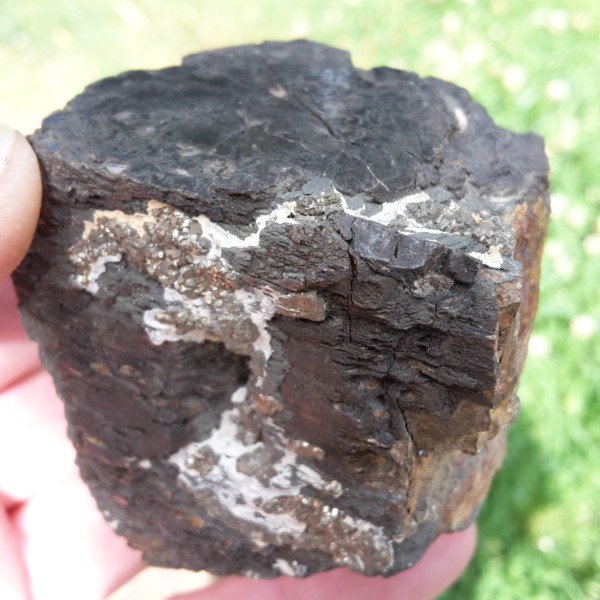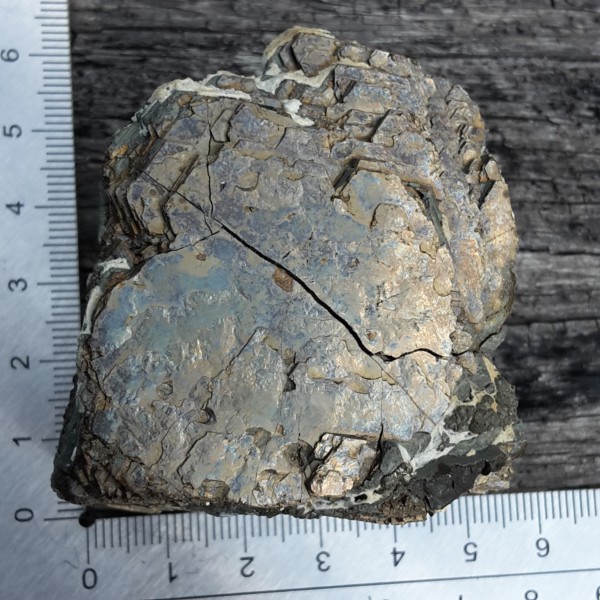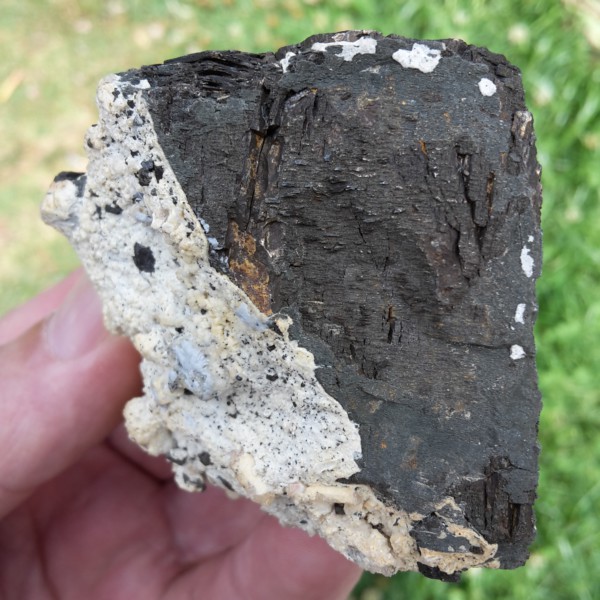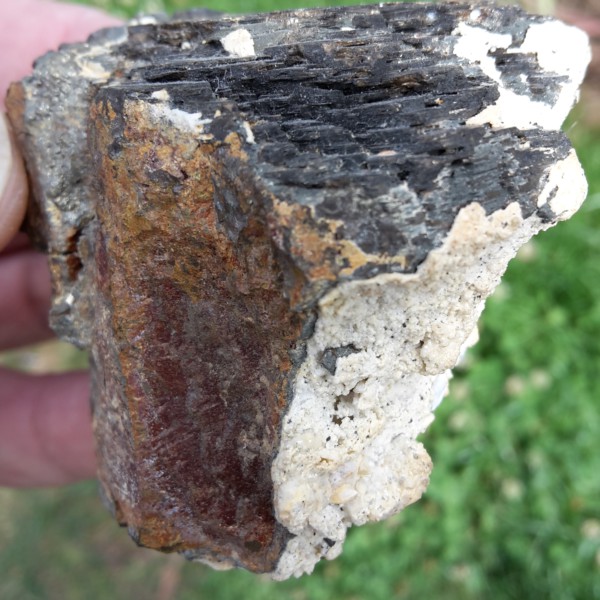No products in the cart.
Metal Specimens, Minerals of the World
PYRRHOTITE OLD STOCK
Availability:
In stock
An amazing mineral Pyrrhotite Old Stock! A collection-worthy piece. This specimen displays a crystal of Pyrrhotite and is from old stock. Pyrrhotite crystals are rare and hard to come by. A single partial crystal with laminated structure, minor surface Pyrite and some Calcite. An interesting difference between Pyrite and Pyrrhotite is a magnet will stick to Pyrrhotite but not to Pyrite. Please read the interesting details below about weakly magnetic and two minerals in one.
Location:
Dimensions:
5cm x 4.8cm x 5.5cm, 299g.
Pyrrhotite: Fe7S8,
$240
In stock
Compare
PYRRHOTITE OLD STOCK
An amazing mineral Pyrrhotite Old Stock! A collection-worthy piece. This specimen displays a crystal of Pyrrhotite and is from old stock. Pyrrhotite crystals are rare and hard to come by. A single partial crystal with laminated structure, minor surface Pyrite and some Calcite. An interesting difference between Pyrite and Pyrrhotite is a magnet will stick to Pyrrhotite but not to Pyrite. Please read the interesting details below about weakly magnetic and two minerals in one.
Location:
Dimensions:
5cm x 4.8cm x 5.5cm, 299g.
Pyrrhotite: Fe7S8,
Also given as Fe1-x (x = 0 to 0.17).
Named in 1847 by Ours Pierre Armand Petit Dufrenoy from Greek “pyrrhos”, flame-coloured. Pyrrhotite has some unusual characteristics. First, it has an unusual formula. The amount of sulfur does vary by roughly 20% or 50 to 55 atoms of sulfur per 50 atoms of iron. Or is it the iron that varies? Really the same difference. Thus the unusual formula of Fe1-xS. Secondly, it has two symmetries.
While this should indicate that there are two minerals and not one, in the case of pyrrhotite, mineralogists have made an exception. When pyrrhotite is low in sulfur and the formula is closer to true FeS, then the structure is hexagonal. But when it is high in sulfur, the structure is monoclinic. Clearly two different symmetries, two different formulae; therefore, two different minerals except, in natural pyrrhotite crystals both phases are present in the same crystal. If you are a purist, you can think of a pyrrhotite crystal as an assemblage of two minerals, but most minerologists treat it as one.
Thirdly, pyrrhotite is magnetic or at least weakly so. It is the next most common magnetic mineral to magnetite. Although not all specimens will show great evidence of magnetism if any, some will attract a paperclip or needle suspended from a string or move the needle of a compass. Massive pyrrhotite is common and magnetism is sometimes the only way to distinguish it from other brassy colored sulfides such as chalcopyrite, pyrite, pentlandite or marcasite. Good crystals are rare and should rightly be treasured as coming from a very unusual mineral.
SKU: M23PH02 Categories: Metal Specimens, Minerals of the World Tags: Fe7S8, Galena, PYRRHOTITE, PYRRHOTITE GALENA SPHALERITE QUARTZ, PYRRHOTITE SPHALERITE QUARTZ, Quartz, sphalerite
| Weight | 299 g |
|---|---|
| Dimensions | 5 × 4.8 × 5.5 cm |
| color | Brass |
An amazing mineral Pyrrhotite Old Stock! A collection-worthy piece. This specimen displays a crystal of Pyrrhotite and is from old stock. Pyrrhotite crystals are rare and hard to come by. A single partial crystal with laminated structure, minor surface Pyrite and some Calcite. An interesting difference between Pyrite and Pyrrhotite is a magnet will stick to Pyrrhotite but not to Pyrite. Please read the interesting details below about weakly magnetic and two minerals in one.
Location:
Dimensions:
5cm x 4.8cm x 5.5cm, 299g.
Pyrrhotite: Fe7S8,
You may also like…
- Crystals, Metal Specimens, Minerals of the World, Top Shelf
PYRITE SUN
A stunning Pyrite Sun. This is a natural formation of Pyrite and something quite different to the usual more cubic looking varieties. Striations radiate out from the centre. Our Suns are hand selected at the source for their excellent quality. We are well known for our metals range and have pyrite specimens showing cubic, orbicular and octahedral crystals, as well as these suns. Pyrite (“fools gold”) is popular with all age groups. A great piece for the collector of unusual pieces. This Pyrite Sun comes with a perspex stand for display and looks even better in person.
Dimensions:
9.5cm diameter, 167g.Location:
Sparta, Illinois, USA.PYRITE FeS2.
SKU: MW7502 - Metal Specimens, Minerals of the World
PYRRHOTITE SPHALERITE QUARTZ
An amazing combo of three great minerals Pyrrhotite Sphalerite Quartz! This location is known for its incredible metal/mineral specimens and this is no exception. An affordable, collection-worthy piece. This specimen displays many classic barrel shaped crystals of Pyrrhotite and is from old stock. Pyrrhotite crystals are rare and hard to come by.
Location:
Dalnegorsk, Russian Federation.Dimensions:
4.9cm x 7.3cm x 6.2cm, 215g.Pyrrhotite: Fe7S8, Also given as Fe1-x (x = 0 to 0.17).
Named in 1847 by Ours Pierre Armand Petit Dufrenoy from Greek “pyrrhos”, flame-coloured. Pyrrhotite has some unusual characteristics. First, it has an unusual formula. The amount of sulfur does vary by roughly 20% or 50 to 55 atoms of sulfur per 50 atoms of iron. Or is it the iron that varies? Really the same difference. Thus the unusual formula of Fe1-xS. Secondly, it has two symmetries.
SKU: M23PH01 - Metal Specimens, Minerals of the World, Top Shelf
CARROLLITE CRYSTAL
A top rare Carrollite Crystal metal specimen to add to your collection. Stunning bright crystal surfaces with sharp edges. Great size. A well formed large, Octahedral Carrollite crystal that comes on display pad to go straight into your cabinet. Check out the pics of this specimen on this page.
Dimensions:
3.2cm x 2.6cm x 32cm, 48g.Location:
D.R. Congo, Africa.Carrollite was discovered in Carroll County, Maryland, and recognized as a mineral species in 1852. Carrollite is collected for its mineralogical rarity, rarity of sizeable crystals, unusual chemical composition (relatively few cobalt-bearing minerals). Also it’s high degree of cubic-crystal development, and associations in composite specimens with such minerals as quartz and calcite.
CARROLLITE
copper cobalt sulfide
CuCo2S4.SKU: M23C02 - Metal Specimens, Minerals of the World, Top Shelf, Uncategorized
CARROLLITE
A top rare Carrollite metal specimen to add to your collection. Stunning bright crystal surfaces with sharp edges. Great size on a Calcite matrix with associated mineral like golden and rainbow Chalcopyrite and others. A well formed large, Octahedral Carrollite crystal is perched prominently on the matrix of this specimen. Check out the video of this specimen on this page.
Dimensions:
9.9cm x 6.1cm x 4.3cm, 308g.
Crystal 14.5mm x 16mm.Location:
D.R. Congo, Africa.Carrollite was discovered in Carroll County, Maryland, and recognized as a mineral species in 1852. It is named for Carroll County. Carrollite is collected for its mineralogical rarity, rarity of sizeable crystals, unusual chemical composition as one of the relatively few cobalt-bearing minerals, high degree of cubic-crystal development, and associations in composite specimens with such minerals as quartz and calcite.
CARROLLITE
copper cobalt sulfide
CuCo2S4.SKU: M22C01 - Uncategorized, Metal Specimens, Minerals of the World
CARROLLITE SPECIMEN
A top rare Carrollite Specimen to add to your collection. Stunning bright crystal surfaces with sharp edges. Great size on a Calcite matrix with associated mineral like golden Chalcopyrite and others. A well formed large, Octahedral Carrollite crystal is perched prominently on the matrix. Check out the pics of this specimen on this page.
Dimensions:
8.8cm x 6.3cm x 6.4cm, 340g.
Crystal 15mm x 10.3mm.Location:
Kamoya Mines, Kambove District Haut – Katanga, D.R. Congo, Africa.Carrollite was discovered in Carroll County, Maryland, and recognized as a mineral species in 1852. It is named for Carroll County. Carrollite is collected for its mineralogical rarity, rarity of sizeable crystals, unusual chemical composition as one of the relatively few cobalt-bearing minerals, high degree of cubic-crystal development, and associations in composite specimens with such minerals as quartz and calcite.
CARROLLITE
copper cobalt sulfide
CuCo2S4.SKU: M23C01
Related products
- Galena, Metal Specimens, Minerals of the World, Top Shelf
GALENA
A large specimen of lustrous truncated Galena showing beautiful cleavage. A very collectable classic metal specimen with cubic crystal form. Featuring imperfect hexagonal crystal shapes with flat tops also stunning glossy reflective faces. Galena is a major ore of Lead and Silver. Hard to photograph showing the true beauty of this specimen, a few pics outside and a few more inside. This is possibly the best Galena specimen we have sold online. This is a large stand out piece.
Location:
Borieva Mine, Madan, Bulgaria.Dimensions:
11.8cm x 9.1cm x 9.7cm, 2675g.PbS or (Pb,Ag,As,Sb,Cu)S.
SKU: MW6946 - Crystals, Metal Specimens, Minerals of the World, Pyrite
PYRITE SUN LARGE
A broken Pyrite Sun Large. This is a natural formation of Pyrite and something quite different to the usual more cubic looking varieties. Striations radiate out from the centre. Our Suns are hand selected at the source for their excellent quality. We are well known for our metals range and have pyrite specimens showing cubic, orbicular and octahedral crystals, as well as these suns. Pyrite (“fools gold”) is popular with all age groups. A great piece for the collector of unusual pieces. This Pyrite Sun comes with a perspex stand for display and looks even better in person. Unfortunately this one was broken in the post but it is very large and would still be good as a display specimen for the collection. Could be used for making jewellery.
Dimensions:
12cm diameter, 267g.Location:
Sparta, Illinois, USA.PYRITE FeS2.
SKU: L0304 - Fluorescent Specimens, Metal Specimens, Minerals of the World
WILLEMITE FLUORESCENT FRANKLIN 010
WILLEMITE FLUORESCENT FRANKLIN 010
Willemite Fluorescent Franklin 010. This specimen is short and long wave fluorescent. Dark grey metal shown in the natural light photos is Zinc ore Franklinite. The white mineral is Mangano Calcite which shows BIP Brief Intense Phosphorescence. Pics taken with shortwave, longwave, and sunlight. Very cool stuff and this is one of our favourite rocks. This particular rock has some green Willemite which is intensely fluorescent with filtered Longwave and Shortwave Torches.
To view this spectacular specimen you will need a UVC Shortwave Lamp and UVA Longwave Lamp. Make sure you wear safety glasses. Willemite Franklinite Calcite is also known as the Christmas Tree Rock for the colours Green and Red. This is a quality collectable specimen with wow factor.
Location:
Trotter Dump, Sterling Hill Mine, Franklin, New Jersey, USA.Dimensions:
5.8cm x 9.6cm x 5.5cm, 464g.Willemite, Zinc Silicate.
Zn2Sio4.Franklinite, Zinc Iron Manganese Oxide
Zn2+Fe23+O4.Calcite, Calcium Carbonate
CaCO3.SKU: G1410 - Crystals, Galena, Metal Specimens, Minerals of the World, Pyrite, Quartz
QUARTZ GALENA SPHALERITE CHALCOPYRITE
 Crystals, Galena, Metal Specimens, Minerals of the World, Pyrite, Quartz
Crystals, Galena, Metal Specimens, Minerals of the World, Pyrite, QuartzQUARTZ GALENA SPHALERITE CHALCOPYRITE
A beautiful mineral specimen featuring Quartz Galena Sphalerite Chalcopyrite crystals. Super cute and collectable, specimens like this are quite fascinating. When looked at under magnification you can really see the shape of each different mineral. I could look at these for hours, in fact I do. If you don’t have too much space left in your cabinet a piece like this covers several different mineral types. A great mineral specimen whether you are a beginner or advanced collector.
Location:
Madan, Bulgaria.Dimensions:
8.6cm x 5.5cm x 5.1cm, 419g.Quartz: SiO2.
Galena: PbS.
Sphalerite: ZnS.
Chalcopyrite: CuFeS2.
SKU: QGSC001 - Metal Specimens, Minerals of the World, Top Shelf
PYRITE SUN MEDIUM
A stunning Pyrite Sun Medium. This is a natural formation of Pyrite and something quite different to the usual more cubic looking varieties. Striations radiate out from the centre. Our Suns are hand selected at the source for their excellent quality. We are well known for our metals range and have pyrite specimens showing cubic, orbicular and octahedral crystals, as well as these suns. Pyrite (“fools gold”) is popular with all age groups. A great piece for the collector of unusual pieces. This Pyrite Sun comes with a perspex stand for display and looks even better in person.
Dimensions:
7.8cm diameter, 98g.Location:
Sparta, Illinois, USA.Pyrite, Iron Sulfide FeS2.
SKU: L0303















